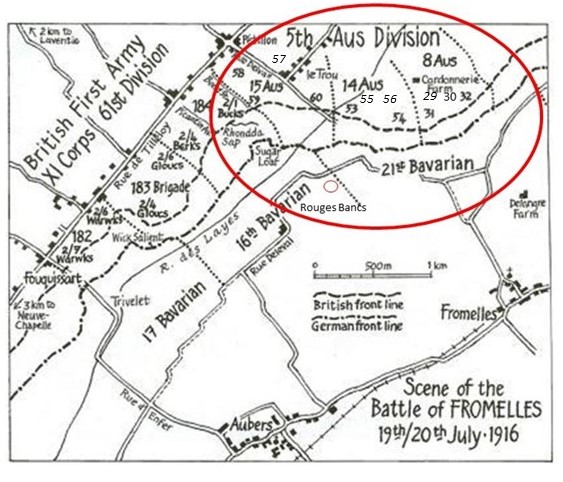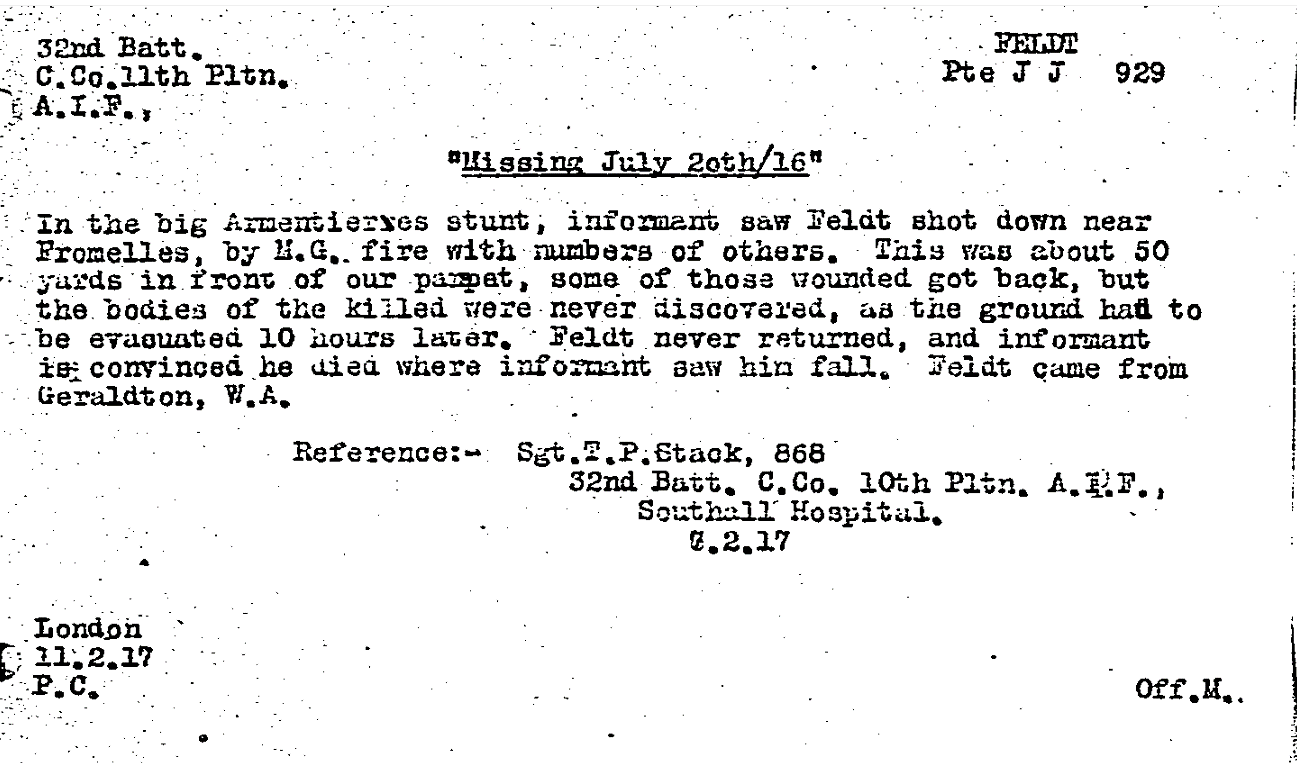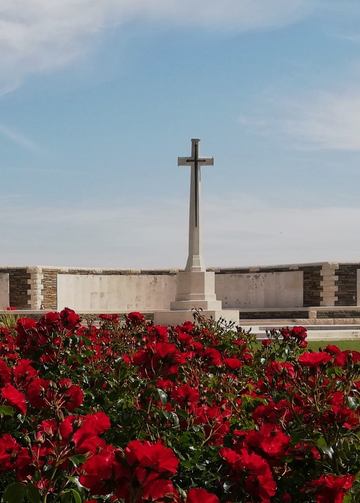Jens Jensen FELDT
Eyes blueish grey, Hair light brown, Complexion fair
A Dane Fighting for Australia
Can you help us identify Jens?
Jens was killed in Action at Fromelles. As part of the 32nd Battalion he was positioned near where the Germans collected soldiers that were later buried at Pheasant Wood. There is a chance he might be identified, but we need help. We are still searching for suitable family DNA donors.
In 2008 a mass grave was found at Fromelles, a grave that the Germans dug for 250 (Australian) bodies they recovered after the battle.
If you know anything of Jens’ contacts here in Australia or his relatives from Horsens Denmark, Netherlands or England, please contact the Fromelles Association.
See the DNA box at the end of the story for what we do know about his family.
Jens’ Background
Jens Feldt’s story is perhaps symbolic of the loss of young life encountered at Fromelles, barely enough life to leave a lasting mark. However, the brevity of his life does not mean a lack of adventure. Jens was born in Horsens, Denmark on 27 May 1882 to Kjerstine Marrie (nee Jensen) and Soren Jensen Feldt.
Jens was their first child together. At the time of his birth, he had a half-sister, Ane Mette Johanne Marie Rasmussen, from his mother’s previous relationship. His brother Alfred Christian Jensen was born in 1884 and his other sister, Henriette Ingeborg Jensen, in 1886. Jens’ father Soren was listed as a “Gartner”, gardener, and Jens seems to have followed family tradition in working the land as he listed his work as a farmer when he emigrated to Australia.
Jens arrived in Fremantle, Western Australia on 1 January 1911. A new year and a new country. He travelled on the SS Gniesenau , which had departed from Bremen, Germany. The ship had travelled via Antwerp, Southampton, Genoa and Colombo with Jens joining the ship in Antwerp. These places must have been eye opening for a young man who appears to have lived all his early life in Denmark. Also on board were many other Danes. Little is known about Jens’ life in Western Australia after landing in Fremantle. On his enlistment papers he lists his occupation as a “lumper”, a labourer who works loading or unloading cargo goods.
To Fight for Australia
What motivated Jens to enlist is not known, but perhaps it was that the war in Europe was “close to home” for a man from Denmark. Denmark’s King Christian X had issued a message of neutrality on 1 August 1914, but their large and powerful neighbour Germany demanded that Denmark lay mine fields in order to establish strict control over maritime traffic to the Baltic Sea. While Denmark had promised some years earlier not to take such a measure, the government gave in to German demands and laid the mine fields. Also, articles had been appearing in the local papers about the difficulties of life in the lowland countries of Belgium and the Netherlands, not far from Denmark.
For example, an affecting article appeared one month before Jens enlisted was entitled “The Starving Belgians”. It outlined:
“…Out here in Australia we can form but a faint idea of the pitiful sufferings of the Belgians…thousands of refugees driven from their country by a savage foe, who, not content with taking possession of the country, has laid it waste with fire and sword…”
With family still in Denmark, perhaps this was becoming too real for Jens. Alternatively, Jens’ enlistment papers show him as a naturalised British subject, so perhaps he simply saw it as his duty to his new country. Jens enlisted at the Blackboy Camp in Geraldton, Western Australia on 15 July 1915 and was assigned to the 32nd Battalion, C Company.
The 32nd Battalion was formed at Mitcham, South Australia on 9 August 1915. A and B Companies were to be from South Australia while C and D from Western Australia.


Jack Joyce 32nd Bn (standing at far right) with group of mates at Blackboy Hill training camp, 30th August 1915. Jens on the far left? 5’10” tall, in European clothes and in the same Company as Jack
The men from WA arrived in Adelaide at the end of August and training for all continued. Jens had made some civilian friends during the 2-1/2 months he spent in Adelaide and after he had left Australia he was in communication with a Miss L Taylor. By tracing the address in the letters, she could have been Lillian Adelaide Taylor, who was born 1883 into a large family and was a similar age to Jens.
The 32nd departed for Egypt on 18 November 1915 on the troop ship HMAT A2 Geelong .
As reported in The Adelaide Register:
“The 32nd Battalion went away with the determination to uphold the newborn prestige of Australian troops, and they were accorded a farewell which reflected the assurance of South Australians that that resolve would be realized.”
Egypt
Jens arrived in Suez on 14 December 1915 and moved to El Ferdan just before Christmas. A month later they marched to Ismalia, then to Tel El Kabir for February and most of March. The next stop was at Duntrooon Plateau and Ferry Post, where they stayed until the end of May, training and guarding the Suez Canal. Their last posting in Egypt was a few weeks at Moascar.
One soldier’s diary complained of being “sick up to the neck of heat and flies”, of the scarcity of water during their long marches through the sand and he described some of the food as “dog biscuits and bully beef”. He did go on to mention good times as well with swims, mail from home, visiting the local sights and the like. Source AWM C2081789 Diary of Theodor Milton PFLAUM 1915-16 You can read Theodor’s Soldier Story here. During their time in Egypt the 32nd had the honour of being inspected by H.R.H. Prince of Wales.
To the Western Front
After spending six months in Egypt, the call to support the British Expeditionary Force on the Western Front came in mid-June. They left from Alexandria on the ship Transylvania on 17th June 1916 and arrived at Marseilles, France on 23rd June 1916.
After arriving in Marseilles, the 32nd departed by train for the two-day trip to Steenbecque and a march to Hazebrouck, about 30 kilometres from Fleurbaix. Their route took them to a station just out of Paris, within sight of the Eiffel Tower, then through Bologne and Calais, with a view of the Channel, and finally headed to St Omer and Hazebrouck.
Theodor Pflaum (No. 327) wrote about the trip in his diary:
“The people flocked out all along the line and cheered us as though we had the Kaiser as prisoner on board!!”
Wesley Choat (No. 68), for one, was glad to be out of Egypt, but he was well aware of what laid ahead:
“The change of scenery in La Belle France was like healing ointment to our sunbaked faces and dust filled eyes. It seemed a veritable paradise, and it was hard to realise that in this land of seeming peace and picturesque beauty, one of the most fearful wars of all time was raging in the ruthless and devastating manner of "Hun" frightfulness”.
Training continued with a focus on bayonets and the use of gas masks, assuredly with a greater emphasis given their position near the front.
Battle
The 32nd moved to the front on 14 July and were into the trenches on 16 July for the first time, only three weeks after arriving in France.

They were reconnoitering the trenches and cutting passages through the wires on the 17th, preparing for an attack, but it was delayed due to the weather. D Company’s Lieutenant Sam Mills’ letters home were optimistic for the coming battle:
“We are not doing much work now, just enough to keep us fit—mostly route marching and helmet drill. We have our gas helmets and steel helmets, so we are prepared for anything. They are both very good, so a man is pretty safe.”
On the morning of the 18th, Jens’ Company went back into the trenches to relieve B and D Companies. B and D rejoined on the 19th. All were in position by 5.45 PM and the charge over the parapet began at 5:53 PM. Jen’s C Company was in the first and second waves to go over the parapet. As the German lines were rushed, the 32nd were able to advance rapidly, taking out a German machine gun in their early advances, but they were under heavy artillery and were being “seriously enfiladed” from their left flank. Jens was unfortunately caught up in this. Despite one soldier reporting that Jens was taken prisoner, other soldiers who knew him well reported that they saw him killed instantly on 19 July.
G. R. Crossing (910) wrote:
“I knew him personally and saw him killed by Machine Gun or rifle fire in No Man’s land on 19th at Fleurbaix. He was killed instantly, it was in a charge. I don’t know whether he was buried.”
Sergeant T. P. Stack (868) confirmed Jens’ fate.

“In the big Armentieres stunt, informant saw Feldt shot down near Fromelles, by M.G. fire with number of others. This was about 50 yeard in front of our parapet, some of those wounded got back, but the bodies of the killed were never discovered, as the ground had to be evacuated 10 hours later. Feldt never returned, and informant is convinced he died where informant saw him fall. Feldt came from Geraldton, W.A.”
Fighting continued through the night. The Australians made a further charge at the main German line, but, there was machine gun fire from behind and from the emplacement at Delangre Farm and they were so far advanced that they were getting shelled by both sides.
At 5:30 AM the Germans attacked from both flanks in force and with bombing parties:
“The enemy swarmed in and the retirement across No Mans’ Land resembled shambles, the enemy artillery and machine guns doing deadly damage.”
What was left of the 32nd had finally withdrawn by 7.30 AM on the 20th. The initial count was devastating – 71 killed, 375 wounded and 219 missing. The total impact was that 227 soldiers of the 32nd Battalion were killed or died from wounds sustained at the battle and of this 176 were unidentified. As of 2023, 41 of the unidentified soldiers have been found from the German mass grave that was discovered in 2008.
Lieutenant Sam Mills survived the battle. In his letters home, he recalls the bravery of the men:
“They came over the parapet like racehorses……… However, a man could ask nothing better, if he had to go, than to go in a charge like that, and they certainly did their job like heroes."
After the Battle
Lillian Taylor made enquiries about Jens to the South Australian Red Cross Information Bureau. From her letter to the Red Cross in October 1916 it appears that she has regularly been writing to and receiving letters from Jens:
“Every mail since his departure since November last we have received communications from him, and not having heard now for 6 weeks, knowing that he would have written if in a position to do so, we shall be glad to know if in the event of death, wounds, missing or illness his name would appear in the casualty lists published in the Adelaide papers. We are uncertain as to this, owing to the 32nd Bn . comprising men from Western Australia of whom he was one. His parents being in Denmark having no friends in SA we have been unable to make enquiry also having heard that the 32nd Bn has suffered very severely in losses of men. We have thought it better to make enquiry on this point before forwarding further parcels …”
Lillian didn’t marry until after the war.
Jens was officially declared as Killed in Action on 12 August 1917.
Jens remains missing until this day.
The Search in Denmark for DNA to Identify Jens
As there have been 41 soldiers from the 32nd that have been identified in the German burial pit, Jens may be one of the remaining 77 unidentified soldiers, we just need DNA donors to be able to provide Jens with “his chance” to be identified.
The Fromelles Association has been looking for some time for Jens’ family in Denmark.
Our search is primarily for the mitochondrial DNA from Jens’ mother Kjerstine Marrie Feldt, via descendants of Jens’ two sisters: older half-sister through his mother, Ane Mette Johanne Marie Rasmussen and younger sister, Henriette Ingeborg Jensen Feldt.
Ane Mette married Knud Charles Kristian Krautwald. They had four children: Herrman Josef Alois, Carl Andreas Heinrich, Agnes Elisabeth and Louis Johannes born.
Agnes married Gautier Jean Valeur van Berkel and they had a daughter, Dorit Helen, recorded in Schiedam, Rotterdam, Netherlands. We cannot find and trace of Dorit or her family after World War 2.
Alternatively, there is Jens’ younger sister, Henriette Ingeborg Jensen Feldt. In the Danish Census of 1930 she is listed as Henriette Ingeborg Ottesen, a wife, living with her daughter Aase Ottesen and another female, Else Pedersen in Thisted, Sofievej, Denmark.
On a Danish genealogical site, members Bente Wanning Møller Poulsen, Inge Christiansen and Inger Toudal posted information about Henriette and Aase. It isn’t known whether these people are family members.
We would hope to finally find this Danish man who gave his life as an Australian soldier.
DNA samples are being sought for family connections to
| Soldier | Jens Jensen Feldt (1882 – 1916) |
| Parents | Soren Jensen Feldt (1856 -?) Denmark and Kjerstine Marrie Jensen (1855 -?) Denmark |
| Siblings | Ane Mette Johanne Marie Rasmussen married Knud Charles Kristian Krautwald | ||
| Alfred Christian Jensen (1884 – ?) | |||
| Henriette Ingeborg Jensen (1886 – ?) married Ottesen |
| Grandparents | |||
| Paternal | Jens Andersen, Denmark and Ane Kirstine Jacobssatter, Denmark | ||
| Maternal | Jens Ovesen, Denmark and Kirsten Jacobsen, Denmark |
Seeking DNA Donors

Contacts
(Contact: royce@fromelles.info or geoffrey@fromelles.info).
(Contact: army.uwc@defence.gov.au or phone 1800 019 090).
Donations
If you are able, please contribute to the upkeep of this resource.
(Contact: bill@fromelles.info ).
